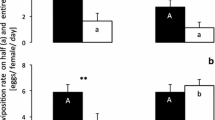Abstract
Caryophyllene is shown to evoke agonistic behavior among nestmates of the leaf-cutting ant Atta sexdens rubropilosa. Laboratory colonies were presented with caryophyllene on an acceptable bait. The behavioral responses observed included repellency, alarm, self-grooming, and arrestant behavior, followed by fighting. When caryophyllene was presented to the workers on inert filter paper fighting did not take place, but the other behaviors were observed. Individual workers smeared with caryophyllene produce an alarm response in nestmates. Caryophyllene produces the strongest reaction in workers that were within 2.5 cm of the source and a variation in sensitivity to caryophyllene appears to exist in different subcastes, with soldiers being the least sensitive. The behavior of the workers to caryophyllene was quantified from video recordings.
Similar content being viewed by others
REFERENCES
Anjos, N., and Santana, D. L. Q. (1994). Alterações deleterias no comportamento de Atta laevigata (F. Smith) e Atta sexdens rubropilosa Forel (Hymenoptera: Formicidae), causadas por folhas de Eucalyptus spp. An. Soc. Entomol Brasil. 23: 225-230.
Arrhenius, S. P., and Langenheim, J. H. (1983). Inhibitory effects of Hymenaea and copaifera leaf resins on the leaf fungus, Pestalotia subcuticularis. Biol. Syst. Ecol. 11: 361-366.
Bonavita-Cougourdan, A., Clément, J. L., and Lange, C. (1987). Nestmate recognition: The role of cuticular hydrocarbons in the ant Camponotus vagus Scop. J. Entomol. Sci. 22: 1-10.
Blum, M. S., Padovani, F., and Amante, E. (1968). Alkanones and terpenes in the mandibular glands of Atta species. Comp. Biochem. Physiol. 26: 291-299.
Bradshaw, J. W. S. (1976). Multicomponent alarm pheromone and defensive secretions of the African weaver ant Oecophylla longinoda (Latreille). Unpublished Ph.D. thesis. University of Southampton.
Bradshaw, J. W. S., and Howse, P. E. (1984). Sociochemicals of Ants. In Bell, W. J., and Cardé, R. T. (eds.) Chemical Ecology of Insects; Chapman and Hall, London, pp. 429-473.
Everaerts, C., Roisin, Y., Qéré, J-L., Bonnard, O., and Pasteels, J. M. (1993). Sesquiterpene in the frontal gland secretions of nasute soldier termites from New Guinea. J. Chem. Ecol. 19: 2865-2879.
Hefetz, A., Errard, C., Chambris, A., and Le Negrate A. (1996). Postpharyngeal gland secretion as a modifier of aggressive behavior in the Myrmicine ant Manica rubida. J. Insect Behav. 9: 709-717.
Howard, J. J. (1987). Leaf-cutting ant diet selection: The role of nutrients, water, and secondary chemistry. Ecology 68: 503-515.
Howard, J. J., Cazin, J. Jr., and Wiemer, D. F. (1988). Toxicity of terpenoid deterrents to the leaf-cutting ant Atta cephalotes and its mutualistic fungus. J. Chem. Ecol. 13: 59-69.
Howard, J. J., Green, T. P., and Wiemer, D. F. (1989). Comparative deterrency of two terpenoids to two genera of attine ants. J. Chem. Ecol. 15: 2279-2288.
Howse, P. E. (1990). Pheromonal control of behaviour in leaf-cutting ants. In Vander Meer, R. K., Jaffe, K., and Cedeno, A. (eds.), Applied Myrmecology—A World Perspective, Westview, PressBoulder, pp. 427-438.
Hubbell, S. P., and Wiemer, D. F. (1983). Host plant selection by an attine ant. In Jaisson, P. (ed.), Social Insects in the Tropics, vol. 2; University of Paris Press, Paris, pp. 133-154.
Hubbell, S. P., Wiemer, D. F., and Adejara, A. (1983). An antifungal terpenoid defends a Neotropical tree (Hymenaea) against attack by fungus growing ants (Atta). Oecologia 60: 321-327.
Hubert, T. D., and Wiemer, D. F. (1985). Ant-repellent terpenoids from Melampodium divaricatum. Phytochemistry 24: 1197-1198.
Morgan, E. D., and Wadhams, L. J. (1972). Chemical constituents of Dufour's gland in the ant, Myrmica rubra. J. Insect Physiol. 18: 1125-1135.
Regnier, F. E., and Wilson, E. O. (1968). The alarm-defence system of the ant Acanthomyops claviger. J. Insect Physiol. 14: 955-970.
Schildknecht, H. (1976) Chemical ecology—a chapter of modern natural products chemistry. Angew. Chem. Int. Ed. Eng. 151: 214-222.
Shorey, H. H., Gaston, L. K., Gerber, R. G., Sisk, C. B., and Phillips, P. A. (1996). Formulating farnesol and other ant-repellent semiochemicals for the exclusion of Argentine ants (Hymenoptera: Formicidae) from citrus trees. Environ. Entomol. 25: 114-119.
Author information
Authors and Affiliations
Rights and permissions
About this article
Cite this article
North, R.D., Howse, P.E. & Jackson, C.W. Agonistic Behavior of the Leaf-Cutting Ant Atta sexdens rubropilosa Elicited by Caryophyllene. Journal of Insect Behavior 13, 1–13 (2000). https://doi.org/10.1023/A:1007749723868
Issue Date:
DOI: https://doi.org/10.1023/A:1007749723868




